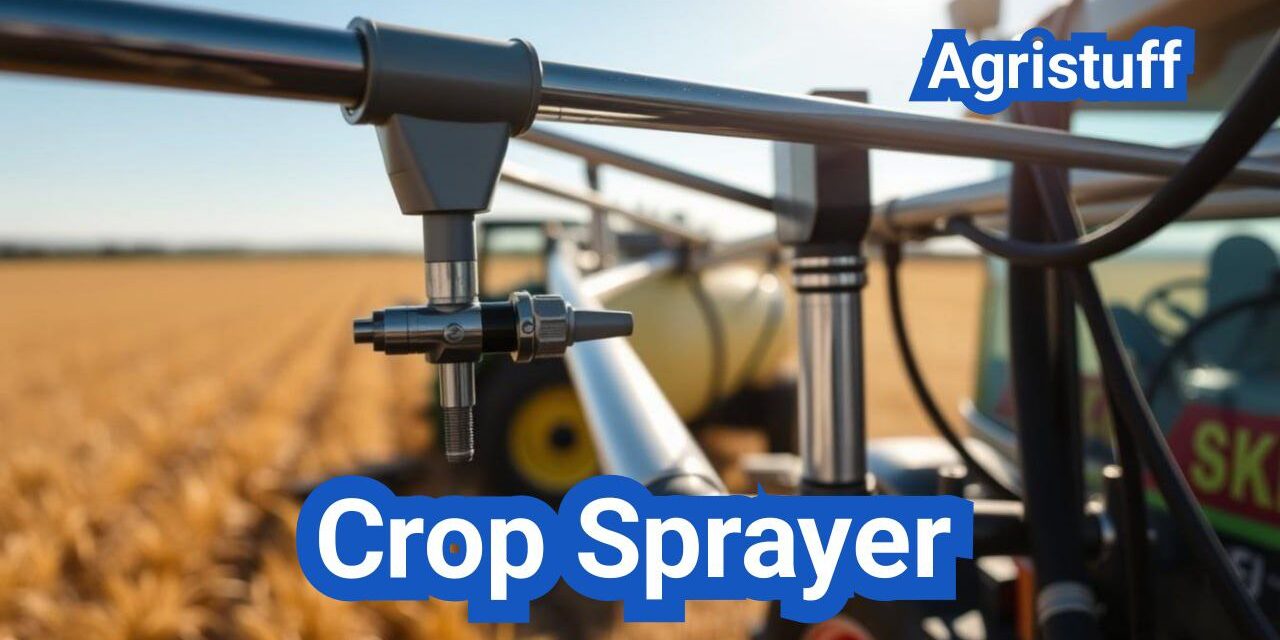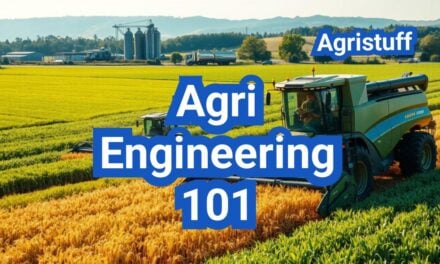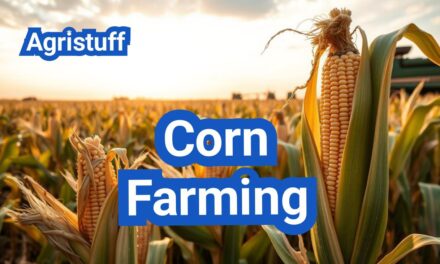Effective pest control is crucial in modern farming, and a well-set-up crop sprayer is key to achieving this. Proper setup ensures uniform coverage, which is vital for preventing crop damage from pesticides.
Calibration of the sprayer, along with the right nozzle selection, plays a significant role in achieving the desired coverage. According to the VEGETABLE PRODUCTION GUIDE, calibration helps in good pest control and prevents damage.
A sprayer calibration involves adjusting the sprayer’s pressure and nozzle configuration to deliver the correct amount of pesticide. This not only ensures effective pest control but also reduces waste and environmental impact.
Key Takeaways
- Proper crop sprayer setup is crucial for uniform coverage.
- Nozzle selection significantly impacts the effectiveness of pest control.
- Sprayer calibration is essential for delivering the correct amount of pesticide.
- Uniform coverage prevents crop damage from pesticides.
- Effective calibration reduces waste and environmental impact.
The Fundamentals of Crop Sprayer Technology
Crop sprayers have evolved substantially, impacting modern agricultural practices. The technology behind these machines has transformed the way farmers apply pesticides, herbicides, and fertilizers, leading to more efficient and effective farming operations.
The Evolution of Crop Sprayers in Modern Agriculture
The development of crop sprayer technology has been driven by the need for more precise and efficient application of agricultural chemicals. Modern crop sprayers are equipped with advanced features such as GPS guidance, automatic section control, and variable rate application systems. These advancements have significantly improved the accuracy of pesticide application, reducing waste and environmental impact.
Precision spraying has become a critical component of modern agriculture, enabling farmers to target specific areas of their fields and apply the exact amount of product needed. This not only improves crop yields but also reduces the environmental footprint of farming operations.
How Effective Spraying Impacts Yield and Profitability
Effective spraying techniques are crucial for maximizing crop yields and profitability. By ensuring that crops receive the right amount of pesticides, herbicides, and fertilizers, farmers can protect their crops from pests and diseases, reduce crop damage, and promote healthy growth.
The proper selection of nozzle type and size is essential for proper pesticide application. According to the guidelines on SPRAYER NOZZLES: Selection and Calibration, choosing the right nozzle can significantly impact the effectiveness of spraying operations. This, in turn, affects crop yields and the overall profitability of farming operations.
By adopting advanced crop sprayer technology and effective spraying techniques, farmers can improve their bottom line while contributing to more sustainable agricultural practices.
Types of Crop Sprayers Used in U.S. Agriculture

The U.S. agricultural sector employs a diverse range of crop sprayers to enhance crop yields and reduce pest damage. These sprayers vary in design, functionality, and application, catering to different farming needs and crop types.
Tractor-Mounted and Pull-Behind Sprayers
Tractor-mounted and pull-behind sprayers are popular among farmers due to their versatility and cost-effectiveness. These sprayers are attached to or pulled by tractors, allowing for efficient coverage of large areas. They are suitable for a variety of crops and can be equipped with different nozzle types and boom configurations.
The key benefits of tractor-mounted and pull-behind sprayers include:
- Flexibility in terms of tank size and boom length
- Compatibility with various tractor models
- Cost-effective compared to self-propelled sprayers
Self-Propelled Field Sprayers
Self-propelled field sprayers offer advanced technology and higher capacity, making them ideal for large-scale farming operations. These sprayers are equipped with their own engines and often feature sophisticated control systems, GPS guidance, and larger tanks.
The advantages of self-propelled field sprayers include:
- Higher spraying capacity and efficiency
- Advanced precision agriculture features
- Reduced operator fatigue due to comfort and automation
Aerial Application Systems: Planes and Drones
Aerial application systems, including planes and drones, provide an efficient means of spraying large areas quickly. These systems are particularly useful for crops that are difficult to access with ground-based equipment or require rapid application.
The benefits of aerial application systems include:
- Rapid coverage of large areas
- Access to difficult or sensitive terrain
- Potential for reduced soil compaction
Cost Comparison Across Sprayer Types
The cost of crop sprayers varies significantly across different types and models. Factors influencing cost include the sprayer’s capacity, technology level, and brand.
| Sprayer Type | Typical Cost Range | Key Features |
|---|---|---|
| Tractor-Mounted | $10,000 – $50,000 | Versatile, cost-effective |
| Self-Propelled | $100,000 – $250,000 | High capacity, advanced technology |
| Aerial Application | $50,000 – $500,000+ | Rapid coverage, access to difficult areas |
When selecting a crop sprayer, farmers must consider their specific needs, including the size of their operation, the type of crops being grown, and their budget. By choosing the right sprayer, farmers can improve efficiency, reduce costs, and enhance crop yields.
Essential Components of a Crop Sprayer System
To achieve optimal crop protection, it’s essential to understand the various components that make up a crop sprayer system. A well-designed crop sprayer is crucial for efficient and effective application of agricultural chemicals.
Tank Design and Material Considerations
The tank is a fundamental component of any crop sprayer system. Its design and material can significantly impact the overall performance and longevity of the sprayer. Tanks are typically made from materials such as stainless steel, polyethylene, or fiberglass, each offering different benefits in terms of durability, chemical resistance, and cost.
Tank Material Comparison
| Material | Durability | Chemical Resistance | Cost |
|---|---|---|---|
| Stainless Steel | High | Excellent | High |
| Polyethylene | Medium | Good | Medium |
| Fiberglass | High | Excellent | High |
Pump Types and Their Applications
The pump is another critical component of a crop sprayer system, responsible for generating the pressure needed to distribute the spray solution. Different types of pumps are suited to various applications and sprayer sizes.
- Centrifugal Pumps: Suitable for low-pressure applications and often used in smaller sprayers.
- Diaphragm Pumps: Known for their durability and ability to handle abrasive materials.
- Piston Pumps: Offer high pressure and are typically used in larger, more demanding applications.
Boom Construction and Configuration
The boom is the structure that supports the nozzles and is crucial for achieving uniform coverage. Boom design and configuration can significantly impact the sprayer’s performance, particularly in terms of stability and height control.
Control Systems: Manual vs. Electronic
Modern crop sprayers often feature advanced control systems that allow for precise management of the spraying process. These systems can range from simple manual controls to sophisticated electronic systems that integrate with GPS and other precision agriculture technologies.
Electronic control systems offer several advantages, including improved accuracy, reduced operator fatigue, and the ability to monitor and adjust spraying parameters in real-time.
How to Select the Right Crop Sprayer for Your Operation

The selection of an appropriate crop sprayer depends on several factors, including farm size and crop type. Choosing the right equipment is crucial for effective crop management and maximizing yield.
Matching Sprayer Capacity to Farm Size
When selecting a crop sprayer, one of the primary considerations is matching the sprayer’s capacity to the size of your farm. A larger farm requires a sprayer with a higher capacity to ensure timely application. For smaller farms, a more compact sprayer may be sufficient, reducing costs and improving maneuverability.
Farmers should assess their acreage and consider the average time available for spraying. This helps in determining the required sprayer capacity. For instance, a farm with 500 acres may require a sprayer with a tank size of at least 200 gallons to minimize refilling stops.
Evaluating Cost vs. Performance Benefits
Evaluating the cost versus performance benefits of a crop sprayer is essential. While a more expensive sprayer may offer advanced features like precision spraying and GPS guidance, it’s crucial to assess whether these features translate into significant yield improvements or cost savings for your operation.
Consider the total cost of ownership, including maintenance, fuel, and potential repairs. A sprayer that offers higher initial cost but lower operating costs over time may be more economical in the long run.
- Initial purchase price
- Operating costs (fuel, maintenance, repairs)
- Potential yield increase due to more precise application
Considerations for Different Crop Types and Growth Stages
Different crops and growth stages require specific spraying techniques and equipment. For example, spraying herbicides on row crops may require different nozzle configurations compared to spraying fungicides on orchard crops.
Understanding the specific needs of your crops at various growth stages is critical. This includes considering factors like droplet size, spray pressure, and boom height to ensure optimal coverage and minimize drift.
| Crop Type | Growth Stage | Spraying Considerations |
|---|---|---|
| Row Crops | Early Growth | Herbicide application, larger droplet size |
| Orchard Crops | Fruiting Stage | Fungicide application, precise droplet size |
Understanding Crop Sprayer Nozzles: The Key to Uniform Coverage
Uniform coverage in crop spraying is directly related to the selection of appropriate nozzles. The right nozzle can significantly impact the effectiveness of pesticide application, ensuring that crops receive the necessary protection without wasting resources.
Common Nozzle Types and Their Functions
Crop sprayer nozzles come in various types, each designed for specific applications. The most common types include:
- Flat Fan Nozzles: These are widely used for broadcast applications and are known for their ability to produce a uniform spray pattern.
- Hollow Cone Nozzles: Often used for applying insecticides and fungicides, these nozzles produce a circular spray pattern with a higher concentration of droplets at the edges.
- Full Cone Nozzles: These nozzles produce a solid cone of spray and are typically used for applications requiring a high volume of spray material.
- Air Induction Nozzles: Designed to reduce drift, these nozzles incorporate air into the spray droplets, making them larger and less susceptible to wind.
The ISO Color Coding System Explained
The ISO color coding system is a standardized method for identifying nozzle types based on their spray characteristics. This system helps farmers and applicators quickly select the correct nozzle for their specific needs.
| Nozzle Type | ISO Color Code | Spray Characteristics |
|---|---|---|
| Standard Flat Fan | Orange | Uniform spray pattern, medium droplet size |
| Low Drift Flat Fan | Green | Reduced drift, larger droplet size |
| Air Induction Flat Fan | Blue | Large droplets with air inclusion, minimal drift |
Selecting Nozzles Based on Application Requirements
Choosing the right nozzle involves considering several factors, including the type of crop, the growth stage, and the specific application requirements. For instance, when applying herbicides, a flat fan nozzle might be preferred for its uniform coverage, while air induction nozzles are better suited for windy conditions to minimize drift.
By understanding the different types of nozzles and their functions, as well as utilizing the ISO color coding system, farmers and applicators can make informed decisions to achieve optimal spray coverage and efficiency.
ASABE Droplet Size Categories and Application Efficiency
The American Society of Agricultural and Biological Engineers (ASABE) has established droplet size categories that play a crucial role in determining the effectiveness of crop spraying applications. These categories provide a standardized framework for evaluating nozzle performance, which is essential for achieving optimal coverage and minimizing drift.
The Six Droplet Size Classifications
ASABE has defined six droplet size classifications, ranging from very fine to extremely coarse. These classifications are based on the droplet diameter measured in microns. The categories are:
- Very Fine (VF):
- Fine (F): 100-175 microns
- Medium (M): 176-300 microns
- Coarse (C): 301-400 microns
- Very Coarse (VC): 401-500 microns
- Extremely Coarse (EC): > 500 microns
Understanding these classifications is vital for selecting the appropriate nozzle for specific spraying tasks.
Matching Droplet Size to Target Pests and Products
The choice of droplet size depends on the target pest, the product being applied, and the application method. For instance, insecticides often require finer droplets to ensure adequate coverage on foliage, while herbicides may use coarser droplets to reduce drift and improve efficacy.
Matching the droplet size to the application requirements is critical for maximizing efficacy and minimizing environmental impact. For example, using very fine droplets for herbicides can lead to increased drift, potentially damaging non-target crops.
How Droplet Size Affects Coverage and Drift Potential
Droplet size significantly influences both coverage and drift potential. Smaller droplets provide better coverage on dense foliage but are more susceptible to drift. Conversely, larger droplets are less prone to drift but may not provide adequate coverage, especially in dense canopies.
The optimal droplet size is a balance between these factors, and it is influenced by factors such as wind speed, spray pressure, and nozzle type. By understanding the ASABE droplet size categories and their implications, farmers and applicators can make informed decisions to enhance application efficiency and reduce environmental impact.
Setting Optimal Spray Pressure for Maximum Effectiveness

Achieving the right spray pressure is vital for maximizing the effectiveness of crop sprayers. Optimal spray pressure ensures that the spray is distributed evenly across the target area, which is crucial for effective pest control and minimizing waste.
The Relationship Between Pressure and Flow Rate
The spray pressure and flow rate are closely related. Pressure influences the flow rate of the spray liquid through the nozzles. A higher pressure typically results in a higher flow rate, but this relationship is not always linear due to factors like nozzle design and fluid viscosity.
Understanding this relationship is crucial for calibrating the sprayer correctly. By adjusting the pressure, operators can achieve the desired flow rate, ensuring that the target area receives the correct amount of spray.
How Pressure Affects Droplet Size and Distribution
Pressure significantly affects the droplet size produced by the nozzles. Higher pressures tend to produce smaller droplets, while lower pressures result in larger droplets. The optimal droplet size depends on the specific application, including the type of pesticide and the target pest.
Moreover, pressure influences the distribution pattern of the spray. Proper pressure ensures an even distribution across the boom, minimizing overlap and reducing the risk of drift.
Pressure Monitoring and Adjustment Techniques
Effective pressure monitoring is essential for maintaining optimal spray pressure. Modern crop sprayers often come equipped with advanced pressure monitoring systems that provide real-time data on pressure fluctuations.
Operators can adjust the pressure using various techniques, including adjusting the pump speed or using pressure regulating valves. Regular calibration and checking of the sprayer equipment are necessary to ensure that the pressure readings are accurate and that the sprayer is operating within the desired parameters.
By understanding and implementing these techniques, farmers and applicators can optimize their spray operations, leading to more effective pest control and reduced environmental impact.
Boom Height and Nozzle Spacing: Achieving Proper Overlap

Achieving uniform coverage in crop spraying is heavily dependent on two critical factors: boom height and nozzle spacing. Proper adjustment of these elements ensures that the spray reaches the target area effectively, minimizing waste and environmental impact.
Calculating Optimal Boom Height for Different Nozzles
The optimal boom height is determined by the type of nozzles used and their spray angle. For most standard flat fan nozzles, a boom height that allows for a 50% overlap between adjacent nozzle sprays is recommended. To calculate this, you need to know the nozzle spacing and the spray angle. For instance, with a 110-degree spray angle and nozzles spaced 20 inches apart, the optimal boom height can be calculated using the formula: Boom Height = (Nozzle Spacing / 2) / tan(Spray Angle / 2). Adjusting the boom height according to the nozzle specifications ensures proper coverage and reduces drift.
Determining Correct Nozzle Spacing and Overlap
Nozzle spacing is another crucial factor that affects the uniformity of spray coverage. The spacing between nozzles on the boom should be such that their spray patterns overlap by about 50% at the target height. For most agricultural applications, nozzles are typically spaced between 20 to 30 inches apart. The exact spacing depends on the nozzle type, spray angle, and the desired application rate. Ensuring the correct overlap prevents both under-application and over-application of the spray material.
Adjusting Setup for Varying Field Conditions
Field conditions can vary significantly due to factors like crop type, growth stage, and terrain. Adjusting the boom height and nozzle spacing according to these conditions is essential for maintaining optimal spray coverage. For example, in dense crop canopies or when applying materials that require more precise targeting, adjusting the nozzle type and spray pressure may be necessary. Regular monitoring and adjustments ensure that the sprayer operates at peak efficiency across different field conditions.
By carefully calibrating boom height and nozzle spacing, farmers and applicators can achieve the desired overlap, ensuring effective crop protection and minimizing environmental impact. Regular checks and adjustments are key to maintaining optimal sprayer performance.
Step-by-Step Sprayer Calibration Methods

To achieve optimal crop protection, it’s essential to understand and implement precise sprayer calibration methods. Calibration ensures that your crop sprayer applies the correct amount of product uniformly across your fields, which is critical for effective pest control and minimizing environmental impact.
The 1/128th Acre Calibration Method
The 1/128th acre method is a widely used technique for calibrating crop sprayers. This method involves measuring the output of your sprayer over a known area (1/128th of an acre) to determine if it’s applying the correct volume per acre. To start, you’ll need to know the nozzle spacing and the area your sprayer covers.
Begin by measuring the distance between nozzles (in inches) and calculating the area covered by one nozzle in square feet. Then, measure the output of a single nozzle over a set distance (usually 340 feet for 1/128th acre) and compare it to the recommended output for your sprayer.
Calculating and Adjusting Spray Volume (GPA)
Spray volume, measured in gallons per acre (GPA), is a critical factor in sprayer calibration. To calculate the GPA, you’ll need to know the sprayer’s output in gallons per minute (GPM) and the area it covers in acres per hour (ACPH). Adjusting the spray volume may involve changing nozzle sizes, adjusting pressure, or modifying the sprayer’s speed.
To adjust GPA, first, calculate your current application rate using the formula: GPA = (GPM x 128) / (MPH x nozzle spacing in inches). If the calculated GPA doesn’t match your target rate, adjust the variables (GPM, MPH, or nozzle spacing) accordingly to achieve the desired application rate.
Using Digital Calibration Tools and Apps
In today’s digital age, numerous digital calibration tools and apps are available to simplify the calibration process. These tools can help you calculate spray volume, determine optimal nozzle configurations, and even monitor your sprayer’s performance in real-time.
Some popular digital tools include sprayer control systems integrated into modern agricultural equipment and standalone apps designed specifically for sprayer calibration. These tools can reduce the time and effort required for calibration, improving accuracy and efficiency.
Creating a Calibration Schedule and Record System
Establishing a calibration schedule and maintaining accurate records is crucial for consistent sprayer performance. Regular calibration ensures that your sprayer continues to apply products at the correct rate, even as nozzles wear or other factors change over time.
Create a schedule based on your sprayer’s usage and the manufacturer’s recommendations. Keep detailed records of each calibration, including the date, nozzle configurations, pressure settings, and any adjustments made. This information will be invaluable for troubleshooting and optimizing your sprayer’s performance.
Precision Agriculture Technology for Crop Sprayers

The integration of precision agriculture technology in crop sprayers marks a significant advancement in modern farming practices. This technology has transformed the way farmers apply inputs, making the process more efficient, accurate, and environmentally friendly.
GPS Guidance and Automatic Section Control
GPS guidance systems enable crop sprayers to navigate fields with high precision, reducing overlap and ensuring that all areas receive the correct amount of application. Automatic section control further enhances this by turning off boom sections when they overlap previously treated areas, minimizing waste and environmental impact.
Key benefits of GPS guidance and automatic section control include:
- Reduced input costs through minimized overlap
- Improved crop yields due to consistent application
- Enhanced environmental stewardship by reducing chemical usage
Variable Rate Application Systems
Variable Rate Application (VRA) systems allow farmers to apply inputs at varying rates across a field, based on specific conditions such as soil type, moisture levels, and crop density. This targeted approach optimizes the use of resources, improving crop health and reducing waste.
The implementation of VRA systems involves:
- Creating detailed field maps that identify areas requiring different application rates
- Integrating these maps into the sprayer’s control system
- Adjusting application rates in real-time as the sprayer moves through the field
Pulse Width Modulation and ExactApply Technology
Pulse Width Modulation (PWM) and ExactApply Technology are advanced features that enable precise control over the application rate, regardless of the sprayer’s speed or pressure. PWM achieves this by rapidly switching nozzles on and off, while ExactApply Technology adjusts the flow rate to match the required application volume.
Integrating Sprayer Apps with Equipment
The integration of sprayer apps with equipment is becoming increasingly popular, offering farmers a user-friendly interface to manage their sprayer operations. These apps can provide real-time data on application rates, field conditions, and equipment performance, enabling more informed decision-making.
Benefits of integrating sprayer apps include:
- Simplified operation and monitoring of sprayer systems
- Enhanced data collection for better farm management
- Improved compatibility with other precision agriculture tools
Implementing Drift Reduction Technologies

Drift reduction technologies play a vital role in modern agriculture by ensuring that pesticides and fertilizers are applied precisely where needed. The importance of these technologies cannot be overstated, as they help minimize off-target damage, reduce environmental impact, and improve crop yields.
Identifying Drift Risk Factors
Understanding the factors that contribute to drift is crucial for effective drift reduction. Key risk factors include wind speed and direction, temperature inversions, nozzle type, and spray pressure. By identifying these factors, farmers can take proactive steps to mitigate drift risks.
Wind speed is a significant factor, as high winds can disperse spray droplets over a wider area. Temperature inversions can also cause drift by trapping spray droplets close to the ground, leading to off-target movement.
Drift-Reducing Nozzle Options
One of the most effective ways to reduce drift is by using drift-reducing nozzles. These nozzles are designed to produce larger droplets, which are less susceptible to drift. Various types of drift-reducing nozzles are available, including air induction nozzles and turbo nozzles.
- Air induction nozzles introduce air into the spray stream, creating larger droplets.
- Turbo nozzles use a specialized design to produce a consistent, coarse spray pattern.
Buffer Zone Management and Planning
Buffer zones are areas around sensitive crops or water bodies where spraying is restricted or modified to prevent drift. Effective buffer zone management involves planning and implementing strategies to minimize drift into these areas.
Farmers can use precision spraying techniques and adjust their equipment to reduce the risk of drift into buffer zones. This may involve using GPS guidance and automatic section control to ensure accurate application.
Weather Monitoring for Optimal Application Timing
Weather conditions play a significant role in drift risk. Monitoring weather forecasts and current conditions can help farmers determine the optimal time for spraying. Avoiding spraying during high winds, temperature inversions, or other adverse weather conditions can significantly reduce drift risk.
By combining drift-reducing technologies with careful planning and weather monitoring, farmers can minimize the risks associated with crop spraying and ensure more effective application of pesticides and fertilizers.
Proper Tank Mixing and Cleanout Procedures
Proper tank mixing and cleanout are essential practices that ensure the efficacy and safety of crop spraying operations. The process involves more than just mixing chemicals; it requires a thorough understanding of chemical compatibility, tank design, and cleaning protocols.
Chemical Mixing Sequence and Compatibility
The order in which chemicals are mixed in the tank can significantly impact the effectiveness of the application. Generally, the sequence starts with water, followed by the addition of chemicals according to their formulation type (e.g., wettable powders, liquids). It’s crucial to consult the product labels and compatibility charts to avoid undesirable chemical reactions.
Key considerations for chemical mixing sequence:
- Always add water first to the tank.
- Follow with wettable powders or dry flowables.
- Liquid formulations should be added next.
- Finally, add emulsifiable concentrates or adjuvants.
Thorough Tank Cleaning Between Applications
Thorough tank cleaning is vital to prevent cross-contamination of chemicals, which can lead to unintended crop damage or reduced efficacy of subsequent applications. The cleaning process typically involves rinsing the tank with water, followed by a cleaning agent, and then a final rinse.
| Cleaning Step | Description | Recommended Agent |
|---|---|---|
| Initial Rinse | Rinse tank with water to remove residual chemicals. | Water |
| Cleaning | Use a cleaning agent to remove stubborn residues. | Commercial tank cleaner |
| Final Rinse | Rinse the tank again with water to remove any cleaning agent residue. | Water |
Preventing Cross-Contamination Issues
Cross-contamination can be prevented by adhering to strict tank cleaning protocols, using dedicated tanks for specific types of chemicals, and ensuring that all equipment is thoroughly flushed between uses. Regular inspection of the tank and its components for signs of wear or damage is also crucial.
Best practices to prevent cross-contamination:
- Use separate tanks for different chemical types when possible.
- Implement a rigorous cleaning schedule.
- Regularly inspect equipment for damage or wear.
Specialized Crop Sprayer Applications in U.S. Agriculture
Specialized crop sprayers have revolutionized agricultural practices in the U.S. by providing tailored solutions for various crops and growing conditions. These advanced sprayers are designed to meet the specific needs of different agricultural operations, enhancing efficiency and productivity.
High Clearance Sprayers for Tall Crops
High clearance sprayers are particularly useful for spraying tall crops such as corn and soybeans. These sprayers are equipped with tall frames that allow them to pass over mature crops without damaging them, ensuring that the crops receive the necessary treatments at the right time.
In-Crop Corn Applications and Timing
In-crop corn applications require precise timing to ensure effective pest control and nutrient delivery. Specialized sprayers enable farmers to apply treatments directly to the crop, minimizing waste and environmental impact.
Hagie and Other Specialized Sprayer Systems
Hagie sprayers are renowned for their high-clearance capabilities and precision application technology. Other specialized systems also offer unique features tailored to specific agricultural needs, providing farmers with a range of options to suit their operations.
Adapting Equipment for Different Growing Regions
Different growing regions present unique challenges, from varying crop types to diverse terrain. Specialized crop sprayers can be adapted to meet these regional needs, ensuring that farmers across the U.S. can optimize their crop management practices.
| Sprayer Type | Key Features | Typical Application |
|---|---|---|
| High Clearance Sprayers | Tall frames, precision nozzles | Tall crops like corn and soybeans |
| Hagie Sprayers | High-clearance, precision technology | Corn, soybeans, and other row crops |
| Specialized Systems | Customizable, region-specific | Various crops across different regions |
Regulatory Compliance and Pesticide Label Requirements
Regulatory compliance plays a vital role in modern agriculture, particularly when it comes to pesticide application and label requirements. Ensuring adherence to these regulations is crucial for environmental safety, human health, and the overall effectiveness of pest control measures.
Understanding Spray Quality Specifications on Labels
Pesticide labels contain critical information regarding application rates, safety precautions, and environmental hazards. Spray quality specifications are an essential component of these labels, dictating the droplet size and other application parameters to minimize drift and ensure target coverage.
The label will often reference the ISO color coding system for nozzles, which correlates to specific droplet sizes. Understanding these specifications is vital for applicators to achieve the desired spray quality and comply with regulatory requirements.
Required Documentation for Commercial Applications
Commercial pesticide applicators must maintain accurate records of their applications, including the type and amount of pesticide used, the area treated, and the date of application. This documentation is essential for demonstrating regulatory compliance during inspections or audits.
- Application records
- Pesticide purchase records
- Employee training documentation
Applicator Certification and Continuing Education
In the United States, pesticide applicators are required to be certified through a state-approved program. This certification process typically involves passing an examination that tests knowledge of pesticide safety, application techniques, and regulatory compliance.
Continuing education is also a critical component of maintaining certification, as it ensures that applicators stay up-to-date with the latest research, technologies, and regulatory changes.
State-Specific Regulations in the U.S.
While federal regulations provide a baseline for pesticide use, individual states may have additional requirements or restrictions. Applicators must be aware of these state-specific regulations to ensure compliance.
Examples include buffer zone requirements, restricted use pesticide designations, and specific reporting requirements.
Troubleshooting Common Crop Sprayer Problems
Troubleshooting common problems with crop sprayers is essential for optimal performance. Crop sprayers are complex machines with multiple components that can malfunction or require adjustment. Understanding how to identify and resolve these issues can significantly impact the effectiveness of crop protection and yield.
Diagnosing Uneven Application Patterns
Uneven application patterns can lead to reduced crop yields and increased costs due to over-application or under-application of chemicals. To diagnose uneven application, operators should first inspect the nozzle configuration and condition. Checking for clogged or worn nozzles is crucial as these can significantly affect spray distribution. Additionally, ensuring proper boom height and alignment is vital for uniform coverage.
Operators should also verify that the sprayer’s boom stabilization system is functioning correctly, as this can impact application uniformity, especially in uneven terrain.
Resolving Pressure Fluctuations
Pressure fluctuations can cause inconsistent application rates and affect droplet size, leading to reduced efficacy of the applied product. To resolve pressure fluctuations, operators should check the pump condition and pressure gauge accuracy. Ensuring that the pump is in good working order and that the pressure gauge is calibrated correctly can help stabilize pressure.
It’s also important to inspect the pressure relief valve and ensure it’s functioning as intended to prevent excessive pressure build-up.
Addressing Nozzle Clogging and Wear
Nozzle clogging and wear are common issues that can lead to uneven application. Regularly inspecting nozzles for wear and cleaning or replacing them as needed is essential. Using nozzle cleaning tools and following the manufacturer’s guidelines for maintenance can help prevent clogging.
Operators should be aware of the nozzle material and its compatibility with the chemicals being applied, as some materials may degrade faster than others.
Preventative Maintenance Schedule
Implementing a preventative maintenance schedule can significantly reduce the occurrence of common crop sprayer problems. This includes regular checks on critical components such as pumps, nozzles, and booms. Keeping a maintenance log can help track when maintenance was last performed and what is needed in the future.
A well-maintained sprayer not only performs better but also extends its operational lifespan, providing a better return on investment.
Maximizing Sprayer Efficiency for Optimal Crop Protection
Maximizing sprayer efficiency is crucial for achieving optimal crop protection. By understanding the fundamentals of crop sprayer technology, selecting the right equipment, and implementing precision spraying techniques, farmers can improve crop yields and reduce environmental impact.
Effective sprayer calibration, proper nozzle selection, and optimal spray pressure are essential for uniform coverage and minimizing drift. Leveraging precision agriculture technologies, such as GPS guidance and variable rate application systems, can further enhance sprayer efficiency.
By following the guidelines outlined in this article, farmers and agricultural professionals can optimize their agricultural spray equipment for optimal application, resulting in improved crop protection and increased profitability.
FAQ
What are the key components of a crop sprayer that need to be set up for uniform coverage?
The key components of a crop sprayer that need to be set up for uniform coverage include nozzles, pressure, and calibration.
How has crop sprayer technology evolved over time?
Crop sprayer technology has evolved significantly over time, from manual spraying to tractor-mounted and self-propelled sprayers, and more recently, to precision agriculture technology, including GPS guidance and variable rate application systems.
What are the different types of crop sprayers used in U.S. agriculture?
The different types of crop sprayers used in U.S. agriculture include tractor-mounted and pull-behind sprayers, self-propelled field sprayers, and aerial application systems, such as planes and drones.
How do I select the right crop sprayer for my operation?
To select the right crop sprayer for your operation, consider factors such as farm size, crop type, and growth stage, as well as the cost vs. performance benefits of different sprayer types.
What is the importance of nozzle selection for uniform coverage?
Nozzle selection is critical for uniform coverage, as different nozzle types and sizes can affect the droplet size and distribution of the spray.
What are the ASABE droplet size categories, and how do they impact application efficiency?
The ASABE droplet size categories are classifications of droplet size, ranging from very fine to extremely coarse, and they impact application efficiency by affecting coverage and drift potential.
How do I calibrate my crop sprayer?
To calibrate your crop sprayer, you can use the 1/128th acre method, calculate and adjust spray volume (GPA), and use digital calibration tools and apps.
What is the role of precision agriculture technology in crop sprayers?
Precision agriculture technology, including GPS guidance, variable rate application systems, and pulse width modulation, plays a critical role in crop sprayers by improving application accuracy and efficiency.
How can I reduce drift when spraying crops?
To reduce drift when spraying crops, identify drift risk factors, use drift-reducing nozzle options, and implement buffer zone management and planning.
What are the proper procedures for tank mixing and cleanout?
Proper procedures for tank mixing and cleanout include following a chemical mixing sequence, thoroughly cleaning the tank between applications, and preventing cross-contamination issues.
What are some specialized crop sprayer applications in U.S. agriculture?
Specialized crop sprayer applications in U.S. agriculture include high clearance sprayers for tall crops, in-crop corn applications, and Hagie and other specialized sprayer systems.
What are the regulatory compliance and pesticide label requirements for crop spraying?
Regulatory compliance and pesticide label requirements for crop spraying include understanding spray quality specifications on labels, maintaining required documentation, and obtaining applicator certification.
How can I troubleshoot common crop sprayer problems?
To troubleshoot common crop sprayer problems, diagnose uneven application patterns, resolve pressure fluctuations, address nozzle clogging and wear, and implement a preventative maintenance schedule.
Conclusion of: Crop Sprayer
Why uniform coverage matters with a crop sprayer
Uniform coverage is the difference between an effective application and wasted input, so the crop sprayer must deliver the right droplet size and volume to every square foot. When a crop sprayer puts down inconsistent rates, you invite escapes, crop injury, resistance selection, and off-target movement that can trigger regulatory issues and neighbor complaints. Getting your crop sprayer right up front is cheaper than fixing problems after the pass. Best Management Practices for Boom Spraying — Ohio State University
Know your crop sprayer components
Before touching nozzles, confirm the crop sprayer’s pump, strainers, pressure regulator, boom plumbing, and gauges are configured correctly and in good condition. A crop sprayer with mismatched strainers or a failing gauge can create unequal pressure at the tip, causing streaks and misses. Start with an inspection and basic service so your crop sprayer behaves predictably during setup and calibration. Calibrating a Low-Pressure Ground Sprayer — Oklahoma State University (PDF)
Nozzle types for a crop sprayer
Nozzles are the heart of a crop sprayer: standard flat-fan, air-induction (pre-orifice), twin-fan, and specialty designs all trade off coverage versus drift. For a crop sprayer targeting contact fungicides or insecticides, smaller droplets often boost coverage; for systemic herbicides, larger droplets can reduce drift while maintaining efficacy when labels allow. Choose the nozzle style that meets label-specified spray quality and the job at hand. Selecting the Best Nozzle for the Job — Ohio State University
Droplet size & ASABE categories: choosing spray quality for a crop sprayer
Every crop sprayer should match nozzle, pressure, and speed to an ASABE S572.1 droplet size category (e.g., Fine, Medium, Coarse, Very Coarse) that the product label recommends. This standard helps a crop sprayer operator align efficacy and drift control by specifying a measurable spray quality rather than vague “micron” targets. ASABE S572.1 Droplet Size Classification (PDF)
ISO colors & reading nozzle numbers on a crop sprayer
On a crop sprayer, nozzle bodies and caps are often color-coded by ISO to indicate flow capacity, and each nozzle is stamped with angle and size (e.g., 110-04 = 110° fan, 0.40 gpm at 40 psi with water). Knowing these markings lets a crop sprayer operator quickly size flow for a target GPA and speed without guesswork. How to Use a Nozzle Flow Chart — Sprayers101
Boom height, spacing, and overlap for a crop sprayer
To achieve uniform overlap, a crop sprayer typically runs 110° flat-fans at about 20 inches above the target with 20-inch nozzle spacing, but the exact boom height depends on tip angle and desired overlap. Too high increases drift; too low creates streaking. Confirm overlap visually and by pattern testing so the crop sprayer produces an even swath. Broadcast Boom Nozzle Spacing & Overlap — Sprayers101
Pressure, flow, and speed: the math behind a crop sprayer
The essential formula for any crop sprayer is GPA = (5940 × GPM) / (MPH × nozzle spacing in inches). This ties the crop sprayer’s nozzle flow, travel speed, and spacing into one equation to hit a label-compliant rate. Because nozzle flow varies with the square root of pressure, doubling pressure only raises flow by ~41%, so speed and tip size often matter more than cranking the gauge. Sprayer Short-Cut Formulas — Montana State University Extension
Step-by-step calibration of a crop sprayer (1/128th-acre method)
The fastest field check for any crop sprayer is the 1/128th-acre method: drive a measured distance for your nozzle spacing, collect each nozzle’s output during that time, and the ounces caught equal your GPA because 128 oz = 1 gallon. This keeps a crop sprayer honest and makes it easy to spot under- or over-applying tips. 1/128th-Acre Calibration — UNH Extension
One-minute output check for a crop sprayer
A simple shop alternative for a crop sprayer is the one-minute method: capture one minute of flow from each tip into a graduated container, convert ounces to gallons, average the nozzles, and plug GPM into the GPA formula. A consistent one-minute check keeps a crop sprayer on target between full calibrations. One-Minute Calibration — UNH Extension
Set pressure where it counts on a crop sprayer
Panel gauges can mislead because they don’t always reflect pressure at the nozzle; if the crop sprayer has long runs, restrictions, or worn regulators, pressure at the tip can differ. When possible, verify pressure at the boom or use a test gauge at the nozzle so the crop sprayer’s indicated droplet size truly matches the chart. Boom Sprayer Calibration — Ohio State University
Drift management & labels for a crop sprayer
Label language often dictates spray quality, boom height, and wind limits; a crop sprayer must comply to keep applications legal and on target. Common ground-boom directions include running a boom ≤4 ft above canopy and spraying under certain wind speeds with the label-specified droplet category. Every crop sprayer operator should read and follow the product label. EPA Drift Label Statements (guidance)
Choosing spray volume (GPA) for a crop sprayer
Application volume influences coverage and performance; dense canopies or contact modes of action usually require higher GPA, while certain systemic herbicides allow lower volumes. Match GPA to label and agronomic goal, then select tips and speed so the crop sprayer consistently delivers that GPA with the right spray quality. Sprayer Nozzle Selection — University of Georgia
Droplet size, drift, and efficacy tradeoffs for a crop sprayer
Larger droplets reduce drift risk but may reduce coverage; smaller droplets increase coverage but drift more. The ASABE categories help a crop sprayer balance these tradeoffs according to label. Choose a nozzle and pressure that put the crop sprayer in the specified category across your operating range. Understanding Droplet Size — Pesticide Environmental Stewardship
Strainers, filtration, and wear checks on a crop sprayer
Clogged or mismatched strainers cause streaks and pressure fluctuations, so every crop sprayer should use the mesh sizes recommended for each nozzle and keep them clean. Replace worn tips that exceed output tolerance, because a worn tip makes the crop sprayer over-apply and wrecks uniformity. TeeJet Line & Tip Strainers (PDF)
Agitation and mixing best practices for a crop sprayer
Suspension products like WPs and WDGs settle without strong agitation, so ensure the crop sprayer delivers enough recirculation and tank movement to keep mixtures uniform. Poor agitation leads to hot and cold streaks that a crop sprayer cannot correct after the fact—uniform mixing is step one of uniform spraying. Boom Spraying BMPs — Ohio State University
Accounting for density and solutions in a crop sprayer
Fertilizer solutions and other liquids don’t behave like water, so a crop sprayer may need correction factors or recalibration when switching carriers (e.g., UAN). Verify the intended rate using the appropriate conversion or by recalibrating so the crop sprayer still delivers the label GPA at field speed. Using Water to Calibrate for Fertilizers — Oklahoma State University
Square-root rule: don’t “fix” a crop sprayer with pressure alone
Because nozzle flow follows the square root of pressure, increasing pressure on a crop sprayer is a blunt tool: a big pressure jump produces a modest flow increase and often shifts droplet size finer than the label allows. Adjust tip size or speed first, and use pressure for fine-tuning the crop sprayer within the nozzle’s recommended range. Pressure–Flow Relationship — Sprayers101
Pattern testing & worn nozzle detection on a crop sprayer
Streaks often come from worn or mismatched tips, so periodically compare tip outputs and inspect the pattern board. Any crop sprayer should replace tips that differ by more than 10% from the set average, and keep spares on hand to avoid finishing a field with a bad pattern. TeeJet Technical Information (wear & testing) (PDF)
Cleanout and contamination control for a crop sprayer
Thorough triple-rinse cleanout prevents crop injury from residues when the crop sprayer switches products or crops. Research shows that diligent water rinses can be highly effective, but always follow the specific label’s cleanout steps and dispose of rinsate properly so the crop sprayer avoids contamination carryover. Removing Herbicide Residues — Purdue Extension
Field checklist before rolling a crop sprayer
Before leaving the yard, confirm on your crop sprayer: correct nozzles installed and tightened, strainers cleaned, leaks fixed, boom height set, pattern checked, speed verified over a measured course, pressure set in the correct range, and GPA confirmed with a quick calibration. This 10-minute routine pays back every acre your crop sprayer covers. UNH Sprayer Pre-Check & Calibration
Recordkeeping, labels, and evolving rules for a crop sprayer
Keep records of field, product, rate, GPA, pressure, speed, nozzle, and weather for every pass a crop sprayer makes; labels increasingly specify drift buffers, droplet categories, and mitigation steps. Good records protect the operator and prove the crop sprayer followed label requirements if questions arise. EPA Spray Drift Mitigation Calculator (User Guide, 2025) (PDF)
Calibration example for a crop sprayer (putting numbers together)
Suppose your crop sprayer targets 15 GPA with 20-inch spacing at 5 mph. Using the formula GPM = (GPA × MPH × spacing) / 5940, each tip should deliver ~0.25 gpm with water. Select a nozzle that delivers that flow in the label-required droplet size category, then verify at the boom so your crop sprayer reliably hits rate and pattern. Sprayer Calibration Fundamentals — Colorado State University Extension
Final thought
A little discipline on nozzle choice, boom height, pressure, and calibration turns any crop sprayer into a precise tool for crop protection and nutrition, delivering label-compliant droplets at the right GPA with minimal drift and maximum efficacy. Keep your program simple, verify in the field, and let the numbers guide every crop sprayer setup. Boom Spraying BMPs — Ohio State University
Sources & References
- ASABE S572.1 Droplet Size Classification (PDF)
- Selecting the Best Nozzle for the Job — Ohio State University
- Boom Sprayer Calibration — Ohio State University
- Calibrating Ground Sprayers Using Shortcut Methods — Montana State University Extension
- 1/128th-Acre Calibration — UNH Extension
- One-Minute Calibration — UNH Extension
- Nozzle Flow Chart & Square-Root Rule — Sprayers101
- Broadcast Boom Nozzle Spacing & Overlap — Sprayers101
- EPA Drift Label Statements (guidance)
- EPA Spray Drift Mitigation Calculator — User Guide (2025) (PDF)
- Sprayer Nozzle Selection — University of Georgia
- Understanding Droplet Size — Pesticide Environmental Stewardship
- TeeJet Technical Information (PDF)
- TeeJet Line & Tip Strainers (PDF)










